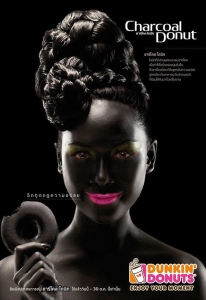The goal of advertisements is to attract the audience and encourage consumers to buy the product. However, advertisements can perpetuate stereotypes in order to do this. For example, an advertisement for a chocolate donut by Dunkin Donuts in Thailand is pictured below:
Dunkin Donuts was marketing their “Charcoal Donut”. In order to do this, as can be seen in the picture, they included a woman with painted black skin holding up a donut with a bite taken out of it. The image is centered on the woman’s face, and the bright pink lips stand in stark contrast to the black skin and background. Since the face is the center, the woman and not the donut is initially highlighted—the woman is the key marketing figure in the advertisement.
This ad adds to the association of chocolate with blackness versus vanilla as whiteness. It claims that blackness is interesting, adventurous, and sinful, while the opposite must be boring and traditional. This campaign includes a video that illustrates this more clearly:
The actress initially has light skin, but the minute she eats the donut, she becomes black with bright pink lips. This develops further and more clearly how the chocolate donut is associated with having black skin and blackness more generally. There is also a sensual aspect to the video, with the close-up of the woman’s mouth and the idea of her being satisfied by eating the donut.
Although most of the advertisement is in Thai, a Time article, http://newsfeed.time.com/2013/08/31/dunkin-donuts-ad-causes-uproar-in-thailand/ mentions that the slogan of this campaign is “Break every rule of deliciousness”. This appeals to the emotion of the viewer who wants to try new and exciting things. This slogan implies that it is perhaps the norm for darker objects to be distasteful or unpleasant, and the charcoal donut is an exception.
Interestingly, while there was uproar against this advertisement in many countries such as America, the Time article details that the campaign was effective in Thailand—donut sales rose. Furthermore, the CEO of Dunkin Donuts Thailand called disapproval of the ad “paranoid American thinking” (Time). This clearly displays the cultural differences of perceptions of race and what is or isn’t a racist message. In an article, Jill Lane explains that blackface in chocolate advertisements are “is a culturally and historically specific ideological process” (382). However, she argues that while there may be some differences in countries’ creation of race distinctions, there is still a “’world racial system’” and history of actions such as slavery that have created global divisions (385).
Facebook comments on a Buzzfeed article about this ad illuminate further the possibility of different interpretations of race : http://www.buzzfeed.com/tasneemnashrulla/racist-dunkin-donuts-ad-in-thailand-uses-blackface-woman-to#.jlO6yYRNd . Some people claim “This is not black face…[this is] using the visuals of charcoal dust” (Shane D Hood August 2013), while others claim “blackface is racist in any country” (Bre Moore August 2013). Other specifically point out that “In the USA this might be considered racist, however, in thaliana where the black community is very minimal, it would not be considered racist” (Sally Parker August 2013). Thus, people can have a wide variety of views about the role of race in this advertisement. It is important to take into account all views and attempt to understand how some people may be offended or hurt by an image while others may not.
In addition to race, this advertisement could have gender role implications. The main model is a woman, with elaborate makeup and an extravagant beehive hairstyle. Visually, the hair takes up almost half of the advertisement. This emphasis on luxury and indulgence of women creates a connection between women and chocolate and enforces a norm of women to be sinful or need chocolate. Robertson’s analysis of gender in chocolate advertisements applies to this: “female consumers are invited to identify with this refined character” (26).
In response to this advertisement, we created an ad that tried to market this charcoal donut in a new way:
This ad contrasts with the original ad by specifically including a diverse group of individuals in the image—thus, instead of creating an association between blackness and the delicious donut, this ad conveys a message that all types of people can represent the donut. We also created a different slogan for the campaign, “Deliciousness has no rules”, which attempts to break the barriers established in society of deliciousness associated with a certain group or look. In this way, this advertisement promotes equality and inclusiveness.
The circle of people imitates the shape of a donut. In comparison to the original advertisement that essential imitated the dark color of the donut in the woman and thus insinuating deeper racial messages, this advertisement is able to use a different aspect of the donut, the shape, to connect people to the donut. The variety of skin colors and cultures represented in this ad serve to showcase that people do not have to change to enjoy the product.
Overall, it is clear that the Dunkin Donuts Advertisement evokes blackface to some viewers, but may not provoke a reaction from people in Thailand. It remains imperative to keep in mind what implications may result from an advertisement and create a sense of inclusion of all types of people rather than a specific association or stereotype such as sin and adventure with blackness.
References
Commercial66able. “Dunkin Donuts Commercial- Thailand Charcoal Donut.”YouTube. N.p., 5 Sept. 2013. Web. 10 Apr. 2015.
Davidson, Jacob. “Dunkin’ Donuts Ad in Thailand Causes Uproar.” Time. N.p., 31 Aug. 2013. Web. 10 Apr. 2015.
Dunkin Donuts Advertisement. Digital image. Adweek. N.p., n.d. Web. 10 Apr. 2015.
Lane, Jill. “Becoming Chocolate, a Tale of Racial Translation.” Theatre Journal59.3 (2007): 382-87. Web. 10 Apr. 2015.
Nashrulla, Tasneem. “Dunkin’ Donuts Ad In Thailand Uses Blackface To Promote Charcoal Donuts.” BuzzFeed. N.p., 30 Aug. 2013. Web. 10 Apr. 2015.
Robertson, Emma. “Introduction and Chapter 1.” Chocolate, Women and Empire: A Social and Cultural History. Manchester: Manchester UP, 2009. N. pag. Print.

